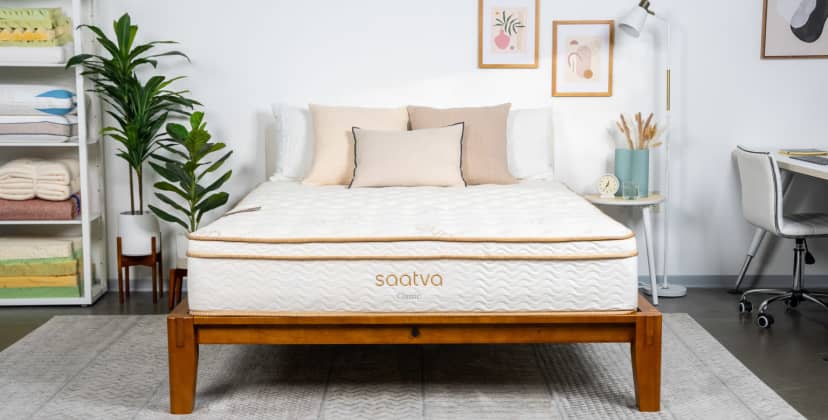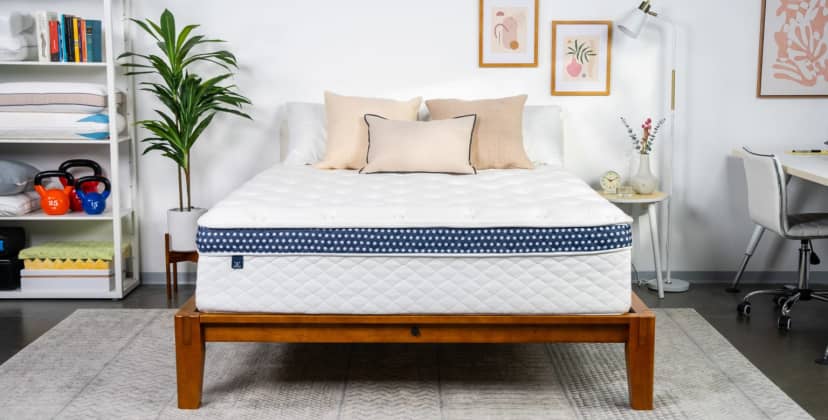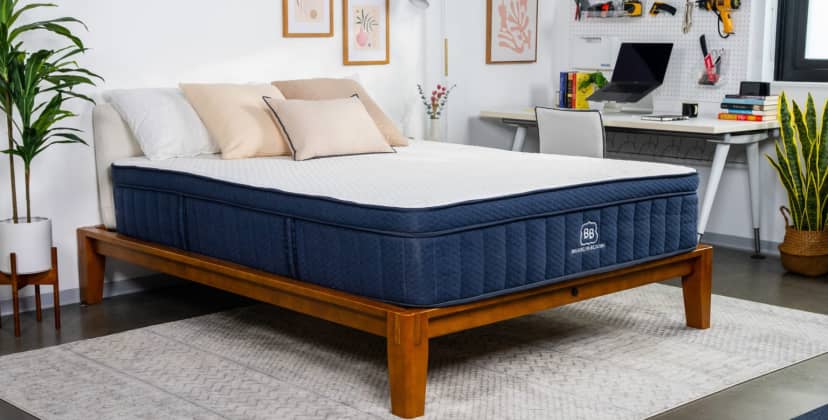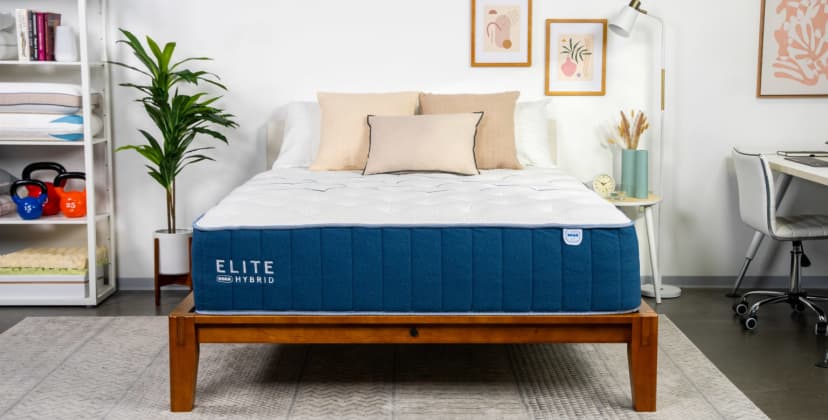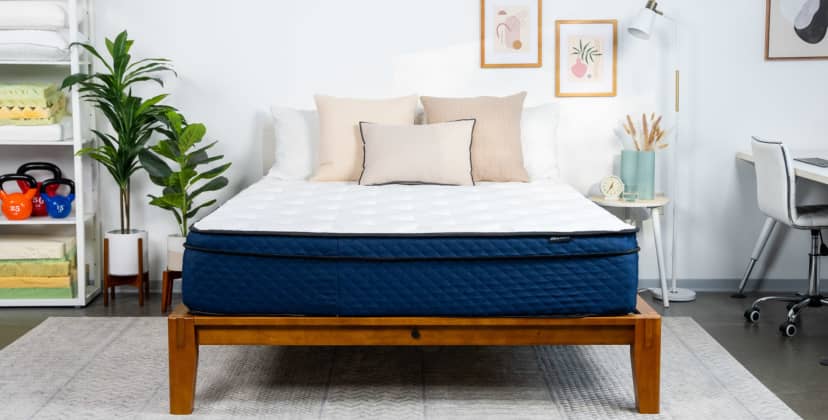When you buy through our links, we may earn a commission. Products or services may be offered by an affiliated entity. Learn more.
Best Hybrid Mattress of 2025
I’ve tested enough mattresses over the past seven years to know one thing for sure: Sometimes, you really can have it both ways. Hybrid mattresses are the proof — blending the cushy comfort of foam with the sturdy support of coils for that just-right feel so many of us are looking for.
Below, you’ll find our testing team’s picks for the best hybrid mattresses, which are based on intensive testing both in our Seattle-based Test Lab and at home. I’ll also go over key considerations for striking out on your own search that can help you find the perfect hybrid mattress for you.
Our Top Picks
- Best Mattress Overall – Helix Midnight Luxe
- Best Value Mattress – Brooklyn Bedding CopperFlex Hybrid
- Best Luxury Mattress – Saatva Classic
- Most Comfortable Mattress – Leesa Sapira Hybrid
- Best Mattress for Back Pain – WinkBed
- Best Mattress for Side Sleepers – Nolah Evolution 15
- Best Cooling Mattress – Brooklyn Bedding Aurora Luxe
- Best Mattress for Pressure Relief – Bear Elite Hybrid
- Best Mattress for Combination Sleepers – Layla Hybrid
- Best Mattress Firmness Options – DLX Premier Hybrid
- Best Mattress for Spinal Alignment – Silk & Snow Hybrid
In-Depth Reviews
The Helix Midnight Luxe is one of my top picks because it strikes such a nice balance between comfort and support. I recommend it to side and back sleepers who want pressure relief without sinking too much, along with solid motion isolation, reliable cooling, and sturdy edges that make the whole surface feel usable.
-
Pros
-
Reinforced perimeter coils add bounce and edge support
-
Foam comfort layers ensure above-average motion isolation
-
Sleeps cooler than many other foam hybrids
-
-
Cons
-
Foam layers may trap emit strong initial off-gassing
-
Inadequate support for stomach sleepers over 230 pounds
-
Mattress Type
Hybrid
Firmness Options
Medium Firm (6)
Price Range
$1,149 – $2,339
Trial Period
100 nights (30-night requirement)
Helix has an extensive line of hybrid mattresses designed for specific types of sleepers in terms of position and body type. The Helix Midnight Luxe is one of the brand’s most popular offerings thanks to a balanced medium firm (6) design that cushions and contours to your body while providing sturdy overall support. Our testing found these qualities make the mattress particularly well-suited to side sleeping.
How It Performed
The mattress performed best among our side sleepers over 130 pounds and most back and stomach sleepers under 230 pounds. The memory foam contoured evenly to reduce pressure for our testers without sinking too much. Reinforced coils along the perimeter limit sinkage when you get in and out of bed. We also found the coils promote enough airflow to help the mattress sleep cool despite memory foam beneath the surface.
A mid-range sticker price makes the Midnight Luxe a compelling choice if you want a well-made hybrid option.
Construction Breakdown
The construction of the Midnight Luxe starts with a Tencel cover that feels smooth and soft, and we found it retains little heat. Below the cover, the comfort system includes two layers of memory foam. Our testers noted these layers compress to accommodate pressure points, but with slightly more bounce and minimal heat buildup compared to other foam hybrids we’ve tested.
Beneath the memory foam is a layer of transition polyfoam. This material felt firmer, working along with the support core to keep you from sinking too far into the bed. The Midnight Luxe’s support core has pocketed coils over dense base foam.
As in other hybrids we’ve tested, these coils improved edge support and responsiveness while transferring less motion than old-fashioned coils. The base foam serves as a shock-absorbing base for the coils.
The Brooklyn Bedding CopperFlex shows you don’t need to break the bank for a high-quality hybrid. Soothing comfort layers, zoned transitional support, and sturdy coils combine for a balanced feel that should appeal to the majority of sleepers.
-
Pros
-
Above-average pressure relief and motion isolation for a hybrid
-
Zoned transitional layer pushes back against the torso and hips
-
Copper-infused foam helps minimize heat buildup
-
-
Cons
-
May not provide enough support for people over 230 pounds
-
Strong off-gassing odor may be present for up to 72 hours after unboxing
-
Mattress Type
Hybrid
Firmness Options
Medium Firm (6)
Price Range
$349 – $699
Trial Period
120 nights (30-night requirement)
Hybrids are among the most expensive mattress types, but some models manage to be relatively affordable without sacrificing quality or performance. Take the CopperFlex Hybrid, one of the newest offerings from Brooklyn Bedding. Six individual layers create a comfy balance of cushioning, support, and bounce, allowing you to sleep soundly without bothersome pressure buildup, yet the sticker price falls well below average for hybrid models.
How It Performed
As a medium firm (6) mattress, the CopperFlex Hybrid fared well among side and back sleepers on our testing team who weigh up to 230 pounds. It was particularly popular with testers who use these positions between 130 and 230 pounds. Side sleepers who weigh less than 130 pounds may prefer the all-foam CopperFlex, which is also medium firm but noticeably plusher and more adaptive.
We were impressed with the CopperFlex Hybrid’s abilities to alleviate pressure points and isolate motion, as coil mattresses tend to struggle in these categories. We attributed strong performance in both areas to the deep comfort system, which contains four foam layers. Sleepers get the close contour they need to reduce pressure buildup along the spine, but the zoned transitional layer prevents them from sinking too deeply. The foam also acts as a muffler for the coils to minimize motion transfer.
Construction Breakdown
The CopperFlex Hybrid’s comfort system contains four layers, beginning with adaptive polyfoam and copper-infused memory foam encased in a Euro-top cover. Another memory foam layer creates additional cushioning, giving the surface an invitingly plush feel when you get into bed, but the fourth layer of zoned transitional polyfoam pushes back against the weight in your midsection to keep your body on an even plane.
The support core consists of pocketed coils over high-density base foam. Thicker coils run the length of both sides to stabilize the perimeter when you sleep close to the edges of the mattress or get in and out of bed.
Unlike a lot of the budget foam mattresses out there, the Saatva has that classic innerspring feel — the kind you’d expect from a high-end hotel. If you’re like me and prefer a little bounce and a plush top (without the deep sink of memory foam), this one’s an excellent pick.
-
Pros
-
Dual-coil design enables excellent airflow
-
Lumbar pad provides additional lower back support
-
Free White Glove delivery
-
-
Cons
-
Returns incur a $99 processing fee
-
Limited motion isolation for couples
-
Mattress Type
Innerspring
Firmness Options
Soft (3), Medium Firm (6), Firm (8)
Price Range
$1,195 – $2,690
Trial Period
365 Nights ($99 Return Fee)
The Saatva Classic is a luxury hybrid that comes in three different firmness options to cater to your unique sleep preferences. With coils in both its support core and comfort system, the Saatva is an innovative take on the traditional innerspring that provides a solid balance of support, pressure relief, and bounce.
How It Performed
You can opt for soft (3), medium firm (6), or firm (8) designs in 11.5- and 14.5-inch profiles. The firm feel was best suited to our testers weighing at least 130 pounds, especially those who sleep on their backs or stomachs. Lighter sleepers who use these positions and side sleepers across all weight groups should feel more comfortable on the soft or medium firm models.
We found cooling to be a major strength of the Saatva Classic. Two coil layers circulate air to help the mattress maintain a comfortable temperature, and the cover is composed of breathable organic cotton. The coil layers also reinforce the edges to prevent sinkage and help you easily get in and out of bed.
Construction Breakdown
We appreciated the Saatva’s luxurious Euro-top design with a moisture-wicking organic cotton cover. The comfort system contains adaptive materials that cushion the body and lighten the impact on your pressure points.
A foam lumbar pad beneath the lower back promoted spinal alignment for our testers, and this is followed by a layer of pocketed microcoils to enhance the bed’s responsiveness. The support core features recycled-steel hourglass coils encased in high-density foam around the perimeter that prevented us from slipping off at the edges.
Our testing team chose this as the best mattress for couples for two reasons: It isolates motion well, and it has strong edge support. It also happens to be a high-quality hybrid bed that performs well in every category.
-
Pros
-
Thick foam layers contour evenly without too much body hug
-
Ventilated top layer helps minimize heat buildup on the surface
-
Reinforced perimeter coils protect the edges from deep sinkage
-
-
Cons
-
Back and stomach sleepers over 230 pounds may not receive enough support
-
Strong off-gassing odor for the first few nights
-
Mattress Type
Hybrid
Firmness Options
Medium Firm (6)
Price Range
$1,349 – $2,299
Trial Period
100 nights (30 night requirement)
The Leesa Sapira Hybrid checks all of the important boxes for couples and has a balanced design that’s suitable for most sleep positions and body types. Our hands-on tests confirm the mattress sleeps cool, isolates motion well, and maintains a stable perimeter to ensure full use of its sleep surface as you and your partner see fit.
How It Performed
The Sapira Hybrid is medium firm (6). As such, the mattress earned especially favorable ratings from our side sleepers weighing at least 130 pounds, and our back and stomach sleepers under 130 pounds. Combination sleepers on our team also appreciated the light responsiveness, allowing them to change positions without feeling stuck.
Most hybrids sleep cool thanks to steady airflow through their coil systems. The Sapira Hybrid takes temperature control one step further with an aerated top foam layer to push airflow near the surface. During our tests, we noticed motion isolation is another strength of the Sapira Hybrid. While many coil mattresses generate motion transfer that can disrupt sleep for couples, this model’s thick foam layers absorb and muffle movement to maintain a tranquil surface.
Construction Breakdown
The Sapira Hybrid’s comfort system contains three foam layers, beginning with plush, adaptive polyfoam quilted to the cover. This layer is ventilated with holes. Underlying memory foam and polyfoam layers provide extra cushioning while pushing back against your weight. Pocketed coils and dense base foam in the support core deliver excellent overall stability, and the reinforced perimeter minimizes sinkage when you get in and out of bed. A breathable knit cover encases the mattress.
The WinkBed offers multiple firmness options and some of the best support I’ve found for keeping your spine aligned. It’s the one I recommend most often (and the one I sleep on at home). And it’s especially good for people dealing with back, shoulder, or hip pain.
-
Pros
-
Euro-top offers cushioning to relieve pressure points
-
Zoned coil system enhances support to lumbar region
-
Reinforced perimeter boosts edge support
-
-
Cons
-
Firmer versions may generate motion transfer and disrupt sleep for couples
-
Thick profile may necessitate a deep-pocket fitted sheet
-
Mattress Type
Innerspring
Firmness Options
Medium Soft (4), Medium Firm (6), Firm (7), Firm (8)
Price Range
$849 – $1,749
Trial Period
120 nights (30 night requirement)
If you prefer a hybrid mattress that offers cushioning while staying responsive, the WinkBed is a first-rate choice. The mattress earns high marks for its overall performance and comfortability. While the bed has a sturdy feel, it also delivers notable pressure relief that we found can help alleviate back pain at night.
How It Performed
The WinkBed comes in three firmness levels — Softer (4), Luxury Firm (6), and Firmer (7) — as well as the WinkBed Plus (8), designed specifically for sleepers over 230 pounds. Depending on the firmness you choose, the WinkBed offers distinct benefits.
The Softer WinkBed earned high marks from our side and back sleepers under 130 pounds, who prefer a bit of extra cushioning. The Luxury Firm model was the most versatile and balanced. Our back and stomach sleepers up to 230 pounds benefitted from this mix of cushioning and support.
Side sleepers between 130 and 230 pounds enjoyed this feel as well. Side sleepers weighing more than 230 pounds, as well as back and stomach sleepers who weigh at least 130 pounds enjoyed the Firmer WinkBed. The WinkBed Plus was a hit among our testers over 230 pounds across sleeping position groups.
Construction Breakdown
All models begin with a quilted Euro-top composed of gel-infused polyfoam inside a Tencel cover. The Softer, Luxury Firm, and Firmer WinkBeds feature a firmer layer of SupportCell polyfoam beneath the pillow-top.
Our testers noted this proprietary material offers even contouring, but a dense composition enables it to push back moderately against your body and keep you from sinking into the core. For additional support, the WinkBed Plus features a layer of latex.
The support core is composed of pocketed coils. These springs are arranged to give the mattress a more robust feel around the edges and in other key support zones. Because they are individually wrapped, each coil retains an independent range of motion, allowing them to react directly to your body’s pressure. As a result, we found these coils can cut down on motion transfer and provide greater spinal support.
With a plush euro-top, ample cushioning, and sturdy support, the Nolah Evolution 15 is incredibly comfortable for side sleepers like me. With three firmness options, side sleepers of any weight should feel supported.
-
Pros
-
Three firmness options
-
Euro-top provides a plush surface feel
-
Perimeter reinforcement enhances edge support
-
-
Cons
-
Limited options for people who want a soft to medium soft mattress
-
All returns incur a $99 fee
-
Mattress Type
Hybrid
Firmness Options
Medium (5), Medium Firm (6), Firm (8)
Price Range
$974 – $2,078
Trial Period
120 nights (30-night requirement), $99 return pickup fee
The Nolah Evolution 15 is a quintessential hybrid mattress, offering an even mix of support and cushioning to ensure healthy sleep posture. Available in three different firmness options, the mattress should feel comfortable for a wide array of sleeper types.
How It Performed
Thanks to the three firmness options, the Nolah Evolution suits a variety of sleepers. Our testing team found the medium (5) feel best suited to side sleepers up to 230 pounds and back sleepers under 130 pounds. The medium firm (6) and firm (8) options were popular among our back- and stomach-sleeping testers.
The three models also had slight differences in performance. All performed well when it came to responsiveness, temperature regulation, and ease of movement, but the medium firm and firm models excelled in these categories.
The firm model also performed slightly better in edge support, making it an excellent choice if you have trouble getting in and out of bed. In terms of pressure relief, the medium feel outperformed other models. Our testers with sharp pressure points and lower back pain benefited from this model.
Construction Breakdown
A cover made from proprietary ArcticTex fabric encases the mattress, which begins with polyfoam quilted into the Euro-top. ArticTex fabric is designed to keep the surface cool to the touch. Next is a layer of proprietary AirFoamICE, a graphite-infused polyfoam meant to conduct heat away from the body to regulate temperature. Our testers noted this layer also gently cradles the body to relieve pressure buildup in the joints.
Two dense polyfoam transitional layers prevent you from sinking excessively and help evenly distribute your weight. Pocketed coils in the support core are zoned around your midsection and the perimeter for extra reinforcement. The coils rest on a base layer made from recycled plant fibers. The bottom half of the encasement features handles, so you can easily move the mattress around.
Infusions of cooling gel and phase change material elevate the Brooklyn Bedding Aurora Luxe over many competing foam hybrids in terms of temperature control. Three firmness levels and zoned coil support add to the appeal of this popular mattress-in-a-box model.
-
Pros
-
Cooling infusions help dissipate heat from the surface
-
Available in three firmness levels
-
Zoned coils provide extra support for the shoulders, back, and hips
-
-
Cons
-
Off-gassing odor can be overwhelming for the first few nights
-
No firmness exchanges during trial period and $99 return fee
-
Mattress Type
Hybrid
Firmness Options
Medium Soft (4), Medium Firm (6), Firm (7)
Price Range
$839 – $2,051
Trial Period
120 nights (30-night requirement)
If you run hot in bed, a mattress that regulates temperature well should be a priority. A lot of brands claim their beds sleep cool, but our testing team can confirm the Brooklyn Bedding Aurora Luxe is the real deal. Foam layers infused with cooling gel and heat-dissipating phase change material offer plushness and cushioning without feeling overly warm. Add the breathable cover and coils that generate steady airflow, and you’ve got a mattress that seems tailor-made for hot sleepers.
How It Performed
The Aurora Luxe is available in medium soft (4), medium firm (6), and firm (7) designs. Our team tested all three. Side and back sleepers under 130 pounds found the medium soft model most comfortable, whereas side and back sleepers over 130 pounds and stomach sleepers weighing at least 130 pounds preferred the firm option. However, the medium firm model was most popular – especially among our testers between 130 and 230 pounds.
Not surprisingly, the Aurora Luxe earned top marks for temperature control. You may notice a bit of heat buildup on the medium soft model, but even that mattress felt fairly cool and didn’t trap too much warmth. The medium soft design excelled at pressure relief and motion isolation, while the medium firm and firm models fared better during our edge support and ease of movement tests.
Construction Breakdown
The Aurora Luxe’s comfort system begins with polyfoam infused with copper and phase change material, which is engineered to capture and release body heat on contact. A second layer of TitanFlex polyfoam gives the surface some stability and bounce, while the transitional memory foam layer adds cushioning. Pocketed coils and dense base foam make up the support core. The coils are divided into three zones, giving you extra pushback around your midsection, and reinforced along the perimeter to bolster edge support. A cover woven with phase change fibers encases the mattress.
For an additional fee, you can upgrade your purchase to include the “Cloud Pillow Top.” This optional foam layer provides even more softness to the surface without changing the overall firmness of the mattress, and it’s GlacioTex cover is designed to feel cool to the touch.
In our testing, the Bear Elite Hybrid stands out as one of the best hybrids for pressure relief, which can make a huge difference if you’re dealing with pain or soreness. It also comes with an optional Celliant-infused cover that’s designed to sleep cool and may help with muscle recovery.
-
Pros
-
Available in three firmness levels
-
Celliant-blend cover keeps the surface cool to the touch
-
Zoned transitional layer feels firmer around the midsection and softer elsewhere
-
-
Cons
-
People weighing more than 230 pounds may sink when moving across the surface
-
Foam layers can produce strong initial off-gassing
-
Mattress Type
Hybrid
Firmness Options
Medium (5), Medium Firm (6), Firm (8)
Price Range
$1,231 – $2,548
Trial Period
120 nights (30-night break-in period)
Pressure buildup during sleep is common, especially if your mattress feels too soft or too firm. The Bear Elite Hybrid is available in three designs, each with a distinct feel to accommodate specific body types and sleep positions. All three models feature adaptive foam layers that contour closely and robust coils that cushion to keep your body on an even plane.
How It Performed
The medium (5) Elite Hybrid earned favorable ratings from our side and back sleepers weighing less than 130 pounds, who enjoyed the deep cushioning and close conforming. Our back and stomach sleepers weighing at least 130 pounds preferred the firm (8) design for its strong support and gentle contouring. If you weigh 130 to 230 pounds, you may find the medium firm (6) model most comfortable. This mattress proved to be the most balanced of the three.
The Elite Hybrid excelled during our temperature control tests. None of our testers reported excessive warmth, and our thermal sensors detected little to no heat retention on the surface. Ease of movement was another highlight. The zoned transitional and support layers deliver enough bounce to prevent sinkage when you move across the surface and sit along the perimeter.
Construction Breakdown
The Elite Hybrid begins with a memory foam comfort layer, followed by a polyfoam transitional layer. The latter is divided into five firmness zones, resulting in a firmer feel beneath the midsection and more give for the head and legs. Pocketed coils and dense base foam make up the support core. The coils are also zoned to reinforce heavier areas of the body.
Celliant fibers and phase change material woven into the cover are intended to dissipate heat. As a result, the Elite Hybrid’s surface should feel cool at all times. A 14-inch profile makes this mattress a high-profile model, so you may need deep-pocket sheets.
Best for Combination Sleepers
Layla Hybrid
Get an extra $10 off with exclusive code: sleepy10
Shop Now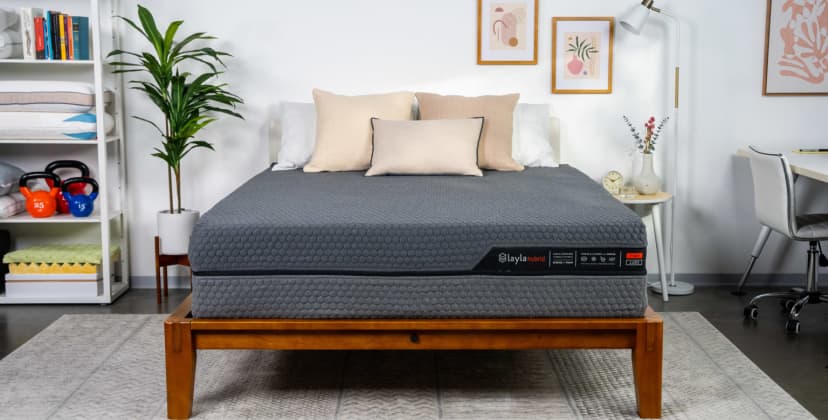
The Layla gives you the best of both worlds: With a different firmness on each side, you don’t have to commit to just one feel. If you like the idea of a memory foam surface but aren’t sure whether soft or firm will suit you best, this flippable design is a smart way to go.
-
Pros
-
Dual-sided with two firmness levels
-
Copper-infused memory foam designed to contour with minimal heat retention
-
Zoned transitional layer for targeted support
-
-
Cons
-
Mattress is somewhat heavy and difficult to flip
-
Those seeking a medium firm feel may not feel comfortable on either side
-
Mattress Type
Hybrid
Firmness Options
Reversible: Medium Soft (4), Firm (7)
Price Range
$1,099 – $1,699
Trial Period
120 nights
Due to its unique flippable design, the Layla Hybrid offers you two firmness levels in one mattress: medium soft (4) and firm (7). This flexible design accommodates a diverse range of sleepers, ensuring optimal support and pressure relief for most people regardless of body type or preferred sleep position.
How It Performed
The Layla Hybrid suited most of our testers across body types and sleeping positions thanks to the reversible design. The firm side was more popular among our testers who weigh more than 230 pounds, who experience better spinal alignment and support for their hips and shoulders with a thinner comfort layer.
Meanwhile, testers below 230 pounds appreciated the deep pressure-relieving cradle of the medium side. The zoned polyfoam transitional layer and pocketed coils support the heavier areas of your body, such as the hips and shoulders, while cushioning your head and neck.
The two sides had slight variations in their performance across our testing criteria. Couples who prioritize motion isolation and noise absorption may appreciate the softer model. The thicker foam comfort system absorbed most movement transfer when our testers rolled across the mattress. The firmer model conforms to the body less, which earned it higher marks in our temperature control tests. Our heat guns detected minimal heat buildup on the surface.
Construction Breakdown
The mattress starts with a memory foam comfort layer on each side that adapts to the body to relieve pressure. These layers are infused with copper meant to keep the bed’s surface cool. Underneath is a zoned polyfoam transitional layer that offers pushback to the midsection and reduces sinkage. The softer side features thicker comfort layers for extra cushioning, while the firmer side’s thinner comfort system ensures an even sleep surface.
Pocketed coils make up the shared support core, offering targeted support to prevent uncomfortable sagging. The bed also features a reinforced perimeter, ensuring sleepers can comfortably use the entire sleep surface without slipping off. A breathable cover made from a stretchy polyester, rayon, viscose, and poly-lycra blend encases the entire mattress.
With six firmness options to choose from, I’ve found the DLX Premier Hybrid to be one of the most versatile hybrids out there. It’s solidly built and, in my testing, performs well where it counts — cooling, edge support, and motion isolation.
-
Pros
-
Available in six firmness options to suit a wide range of sleepers
-
Strong edge support and good motion isolation for couples
-
Solid construction with great cooling performance for a hybrid
-
-
Cons
-
On the pricier side compared to some other hybrid models
-
You may need to invest in a deep-pocket fitted sheet
-
Mattress Type
Hybrid
Firmness Options
Medium Soft (4), Medium Firm (6), Firm (8)
Price Range
$1,699 – $2,499
Trial Period
120 nights (30-night requirement)
Many hybrids are available in two or three firmness levels to account for different body types and sleep positions. With the DLX Premier Hybrid, you can choose from six firmness options. These include medium soft (4), medium firm (6), firm (8), and a split design with any of these feels on the left and right sides. This range of designs should accommodate virtually anyone, including co-sleepers who disagree on which level of firmness feels comfortable.
How It Performed
Our testing team evaluated all three of the Premier Hybrid’s standard firmness options, as well as a split medium soft and medium firm model. Side sleepers up to 230 pounds and back sleepers under 130 pounds enjoyed the deep contour of the medium soft, whereas our testers who use these positions and weigh more preferred the medium firm or firm. Most stomach sleepers felt comfortable on the firm model, though some weighing less than 130 pounds gravitated toward the medium firm instead.
The Premier Hybrid’s thick foam layers ensure above-average motion isolation — even with the firm model, our testers felt very little movement lying side by side on the mattress. At the same time, the viscose batting keeps the surface cool and prevents the foam from trapping too much heat. The firm model excels at edge support and ease of movement, whereas the medium soft and medium firm are better fits if you deal with frequent pain or pressure points.
Construction Breakdown
The Premier Hybrid’s topmost layer contains shredded viscose, a plant-derived material known for its cooling and moisture-wicking abilities. The first foam layer is fairly adaptive, so there’s some initial plushness when you get into bed, while the next two layers are denser to prevent you from sinking too deeply into the mattress — though people over 230 pounds may still sink on the medium soft model.
The support core contains pocketed coils over dense base foam. Thicker coils line the perimeter to stabilize the mattress when you get in and out of bed or roll toward the edges while you sleep. A knit polyester cover encases the entire mattress. The profile measures 14 inches thick, so you may need to invest in a deep-pocket fitted sheet.
Even spinal alignment is key for a healthy night’s sleep, and in our testing, the Silk & Snow Hybrid really delivers on that front for a wide range of sleepers. It’s also one of the more affordable hybrids I’ve come across — especially great for side sleepers.
-
Pros
-
Foam layers provide strong pressure relief
-
Zoned coils offer enhanced lumbar support
-
Airflow through coils helps cool the bed
-
-
Cons
-
Limited support for people who weigh more than 230 pounds
-
Coils can cause motion transfer and disrupt sleep for couples
-
Mattress Type
Hybrid
Firmness Options
Medium Soft (4), Medium Firm (6)
Price Range
$650 – $950
Trial Period
365 nights (30-day requirement)
The Silk & Snow Hybrid is a well-rounded bed made of foam and a pocketed coil core. This balanced design is a good fit if you seek strong cushioning along the spine without sacrificing support for healthy sleep posture, even if you frequently switch positions at night.
How It Performed
Of all the sleep positions, side sleepers on our team found this bed most comfortable. This sleep position exerts extra pressure on the shoulders and hips, so the foam layers should minimize pressure buildup in these areas.
Our back sleepers up to 230 pounds also found this bed fairly comfortable. We found that this bed sleeps fairly cool, thanks to the air circulation through the coils. In addition, the foam layers aren’t exceptionally thick, so they contour your body less and ultimately trap less heat than thicker foam layers.
Construction Breakdown
The mattress begins with a layer of quilted polyfoam, followed by a layer of high-density memory foam. These layers closely contour to your body to alleviate pressure buildup. The support core is composed of pocketed coils that respond to your body but also push back to generate support. The coils are zoned with enhanced lumbar support to ensure your midsection won’t sink in excessively. A polyester and spandex cover is engineered to reduce antimicrobial growth.
Video: We Tested the Best Hybrid Mattresses of 2025 – Here Are Our Favorites
Watch our video below to learn more about our lab’s top picks for hybrid mattresses.
What Is a Hybrid Mattress and How Is It Made?
The name pretty much gives it away — a hybrid mattress is made with a mix of materials. That stands in contrast to other mattress types, such as all-foam, all-latex, or innerspring mattresses. Specifically, the top layers (known as the “comfort system,” in mattress lingo) are made with materials like foam, latex, wool, or micro-coils.
The bottom part (the “support core”) of a hybrid includes steel coils. Most hybrid coils are encased, or “pocketed,” in fabric and engineered to move independently, reducing motion transfer on the surface without sacrificing reinforcement. Some hybrids use the non-pocketed coils found in traditional innersprings. These models may be easier to move on, but tend to transfer more movement and disrupt sleep for couples. Many hybrids also include dense foam base layers.
Hybrid mattresses give companies the flexibility to mix and match materials — like memory foam, latex, quilted pillow-tops, or gel infusions — layering them in different ways to create distinct feels and performance features. Some configurations are better at pressure relief, others offer more targeted support, and some are designed to sleep cooler. That’s why it’s always important to look at the specifics of how a hybrid is built.

Hybrid beds are composed of a comfort system on top and coils on the bottom.
Who Should Buy a Hybrid Mattress?
The reality is that because hybrid mattresses come in so many varieties, they can suit almost any sleeper. But for now, I’ll focus on the people who tend to get the best results from the most common type of hybrid built for steady, across-the-board performance.
People Who Want Both Cushioning and Bounce
One of the things I love most about a hybrid is that you get pressure relief from the top layers along with bounciness from the coils. If you lean toward more cushioning, you can opt for a foam hybrid, and if you want more bounce, a latex hybrid is the better choice.
Sleepers Over 230 Pounds
In our tests, we’ve found that people over 230 pounds frequently say they feel better supported on hybrids than many other mattress types. The coils in a hybrid provide essential support, while the comfort layers help accommodate pressure points like the lower back, hips, and shoulders.
Hot Sleepers
Coils allow air to flow through the coils, permitting natural ventilation that helps keep body heat from building up in a hybrid mattress. I’ve found that latex hybrids, in particular, work great as a mattress for hot sleepers, since latex also resists body heat collection (memory foam not so much).
Who Are Hybrid Mattresses Less Than Ideal For?
Hybrids have broad appeal, but that doesn’t mean that they suit everyone. Certain sleepers should tread carefully when considering a hybrid.
Those Wanting Deep Contouring
People who want to sink into a deep hug from their mattress aren’t the ideal match for most hybrid models. While hybrids with memory foam will contour to the body, they rarely offer a more extreme hug-like sensation that you can get from a soft all-foam bed.
Couples Who Are Light Sleepers
Bounce from the coils in a hybrid can sometimes cause vibrations to spread across the mattress surface, also known as “motion transfer.” For me, it’s usually not enough to cause major sleep disruptions (I’ve learned to sleep with a restless partner and way too many dogs in the bed), but it may be a bigger issue if you or your partner are easily awoken.
Shoppers on a Tight Budget
While prices for hybrids vary considerably, these are rarely the cheapest mattresses available. Because of their strong performance, hybrid mattresses tend to offer great value, but they may be too expensive for shoppers on a very tight budget.
How to Choose the Best Hybrid Mattress for You
Every hybrid shares some basic characteristics, but the devil is in the details. For example, a hybrid with soft memory foam at the top will perform very differently than one with a top layer of latex. The advantage of this is that you have no shortage of mattresses to choose from. But this is far from shooting fish in a barrel — you’ll want to choose wisely.
Sleep Position and Body Weight
I’m going to let you in on a key insight that I wish I’d learned earlier: The first rule of mattress shopping is factoring in your sleep position and body weight. It’s kind of like shopping for a new pair of pants. Color, texture, and style are irrelevant if the pants don’t fit.
But how exactly do you know which hybrid mattress is the right fit? Start by considering your most common sleep position, either on your side, back, or stomach. Your sleep position dictates where your body makes contact with the mattress the most. For back and stomach sleepers, the main pressure point is usually the lower back. For side sleepers, it’s the bottom hip and/or shoulder.
Your body weight also affects how much you push down into a mattress (a tip of the cap to gravity on this one). Your mattress should have the right firmness level that blends cushioning and stability for your specific body weight).
If that sounds like a lot to sort through, I’ve prepared a quick cheat sheet. It shows our Test Lab’s recommended firmness range on a scale of 1 to 10 (10 being the firmest possible), based on your weight and sleeping position.
| Body Weight | Side Sleepers | Back Sleepers | Stomach Sleepers |
|---|---|---|---|
| Less than 130 lbs. | Soft (3) to Medium Soft (4) | Medium Soft (4) to Medium (5) | Medium (5) to Medium Firm (6) |
| 130 to 230 lbs. | Medium (5) to Medium Firm (6) | Medium Firm (6) to Firm (7 or 8) | Medium Firm (6) to Firm (7 or 8) |
| More than 230 lbs. | Medium Firm (6) to Firm (7 or 8) | Firm (7-8) to Extra Firm (9) | Firm (7 or 8) to Extra Firm (9) |
These recommendations won’t work perfectly for everyone. From your own experience, you may know that a softer or firmer mattress works best for you. But if you’re just starting to look at hybrid mattresses, our team has found that these firmness ranges work well in most cases.
Contouring and Pressure Relief
As I’ve tested mattresses, I’ve noticed that the main way that I feel the difference is in how much the mattress contours to (or hugs) my body. In hybrids, that means how the comfort layers are constructed.
Memory foam layers tend to have the deepest contouring, as they conform to your body’s shape. Latex layers only lightly cradle the body, while many polyfoam materials (often specially formulated for certain mattress brands) fall somewhere in between.
Side sleepers often need a deeper embrace to provide enough cushioning to soften impact around the bottom hip and shoulder. But too much give is counterproductive if it causes the mattress to lose its structural integrity.
For back and stomach sleepers, deep hug usually causes the midsection to sag down into the bed and out of line with the rest of the spine. A light touch of contouring tends to work best in these sleep positions.
It can be tricky to know exactly what level of contouring is best, so here’s my advice: Lean toward a mattress with moderate contouring unless you’re a side sleeper with broad shoulders or you know that you prefer a big hug from your mattress.
Ease of Movement
Old school, coil-style mattresses feel springy, almost like a trampoline. Hybrids don’t bounce to that degree, but they usually have enough springiness to let you move easily on the mattress surface.
But just how easy it is to move depends on the materials in the comfort system. Memory foam has virtually no bounce, so it raises the risk of feeling stuck (especially if you choose a plush firmness level). On the other end of the spectrum, latex is bouncy in its own right, so latex hybrids facilitate smooth, resistance-free movement.
Temperature Regulation
The first few hybrid mattresses that I tested slept incredibly cool, so I figured that it was nearly impossible to overheat on a hybrid. But that’s not the case. While ventilating airflow can move through the coils on any hybrid, that doesn’t guarantee that heat won’t build up in the top layers closest to your body.
I find that hybrids tend to have better temperature regulation than all-foam beds. But there’s still a chance of waking up in a sweat if the top layers absorb heat.
If you’re a hot sleeper, a latex hybrid is the most reliable choice for sleeping cool. I recommend that hot sleepers be cautious about buying a memory foam hybrid, especially if the foam is plush. Cooling components, like a specialty cover or gel infusion, may reduce heat buildup, but at the end of the day, our tests show that some cooling features may not fully prevent heat retention.
Shopping for Couples
It takes two to tango, and, if you share your bed, two to buy a mattress. Technically, you could ignore your bed partner’s preferences, but that’s not a good strategy for preserving household harmony.
One big plus for hybrid mattresses is that most of them have a balanced feel, which often means that they will work well for couples, even if your mattress preferences don’t perfectly align. On the other hand, the springiness of a hybrid can mean that movement on one side of the mattress can disturb the person on the other side.
There’s not always a perfect solution here. If you have different mattress needs, look for a hybrid with solid all-around performance. That’s most likely to keep each person happy and keep motion transfer in check.
If you really can’t strike a compromise, consider a split king size with different firmness levels on each side. A less appealing but potentially viable option is to put a mattress topper over one half of the mattress to adjust its feel.
Pricing
Last but not least, you’ll need to think about pricing when shopping for a mattress. For queen size mattresses, most hybrids cost somewhere between $1,000 and $2,000, but you’ll find outliers above and below that range. Price doesn’t perfectly represent quality, but it’s true that a really cheap mattress probably won’t be as supportive or durable.
My recommended approach is to set a ballpark budget with rough numbers for what you’d like to spend and what you’re willing to spend. Use those numbers to whittle down your options, and from there, you can find a great value at a price that you’re comfortable with.
What I’m Sleeping On
I’ve been sleeping on my WinkBed for about five years now. I love it so much that when I upgraded to a king-sized bed, I didn’t hesitate to repurchase it in the new size. Safe to say, I’m a big fan of this hybrid.
For me, it checks all the boxes of what a great hybrid mattress should have: plush, hotel-style comfort from the Euro-pillow top, solid pressure relief from the foam layers, and a sturdy, supportive base of individually wrapped coils. I don’t love the feel of all-foam beds, so when people ask me for a recommendation, the WinkBed is my go-to.
How We Test: Your Comfort Is Our Science
Your sleep is our priority. Our industry-leading testing team is dedicated to doing all the legwork required to present you with the best sleep products, including hybrid mattresses.
Our Test Lab is based in Seattle, and that’s where the magic happens. We use a detailed testing process to gather both objective and subjective data about how well a mattress performs. Each mattress we test goes through a four-step evaluation process.
Construction analysis: For every hybrid mattress, we thoroughly analyze how it’s built. We look at the bed’s materials, firmness options, and other special features (like cooling technologies). We also consider a brand’s reputation and track record.
Quantitative product testing: During hands-on lab tests, our team uses various tools and technology to evaluate a bed’s performance in categories like motion isolation, pressure relief, temperature control, and edge support. We use the outcomes from these tests to calculate a score for each category.
Field testing: Each bed we recommend has gone home with a member of our testing team. Our field testers sleep on the mattresses in their own bedrooms for one to two weeks, and after that, they provide a detailed review of their experience, which helps refine our ratings.
User feedback: We supplement our own testing and research with insight from surveys and reviews from verified customers, and this allows us to round out our assessments with real-world data.
How We Determine Our Overall Scores

To determine a mattress’s overall score, we look at performance in six key categories. We give more weight to the categories with the biggest impact on sleep satisfaction. For instance, pressure relief and temperature control tend to matter more to people than something like off-gassing, which is a temporary issue.
Performance Categories
Motion Isolation
Motion isolation, which we measure with a vibrometer, describes how well a mattress absorbs vibrations when there’s movement on the mattress surface. A higher score for motion isolation means fewer risks of sleep disruptions from a bed partner’s tossing and turning.
Temperature Control
To see how well a mattress regulates temperature, we perform surface temperature mapping with a heat gun, which shows how quickly heat builds up and dissipates. These tests can help identify hybrids that sleep cool.
Pressure Relief
A bed with strong pressure relief excels at preventing impact around hot spots like the shoulders and hips. Hybrids can have vastly different levels of pressure relief based on how they are constructed. We use pressure mapping technology to gauge a bed’s performance in this category.
Ease of Movement
Ease of movement refers to how smoothly you can adjust your body’s position on the mattress surface. With their bounce, hybrids tend to perform well in this category, although the actual score for any given hybrid depends on the composition of its comfort layers.
Edge Support
We measure how much a mattress sags when someone sits or lies down near the perimeter, as well as how quickly it springs back when they get up. Hybrids frequently offer great edge support, but, as with other categories, it depends on the materials in the top layers.
Off-Gassing
After being shipped in a box, a mattress may release unpleasant chemical smells for a few days after it is set up. Foam materials cause the most off-gassing, so hybrids usually have fewer odors than all-foam beds.

More Mattress Guides
Still haven’t found your perfect mattress? For more help deciding which mattress is right for your specific needs, check out the guides below.
Best Mattresses by Type
Frequently Asked Questions
Is a hybrid mattress better than memory foam?
I wish there were a simple yes-or-no answer to this question, but there’s not. The truth is that it depends.
For many sleepers, a hybrid is better than an all-foam mattress because of its more balanced, stable, and bouncy feel. I personally find that hybrids tend to feel more supportive. But other people love the feel of a memory foam mattress, especially if they prefer a mattress that deeply hugs their body.
Do hybrid mattresses need a box spring?
Most hybrid mattresses don’t require a traditional box spring. Instead, they work best on a solid platform bed, slatted base (with slats typically no more than 3 to 4 inches apart), or an adjustable base for proper support and airflow. Always check the manufacturer’s guidelines to be sure.
Are hybrid mattresses good for your back?
Because of their balanced performance, hybrid mattresses can be good for many people with back pain. The combination of a pressure-relieving comfort system with a sturdy and supportive sleep surface can help many people rest in a posture with a neutral spine.
That said, picking a hybrid mattress at random won’t lead to proper back support. You can maximize your comfort and support by accounting for key factors — like your sleeping position, body weight, and optimal firmness — when choosing a mattress.
What is the best coil count and gauge for a hybrid mattress?
There is no “best” coil count for a hybrid mattress. In fact, coil count is not a useful metric for judging a hybrid’s quality. Our tests show little variation in performance between hybrids with low and high coil counts.
Gauge, or coil thickness, is more relevant, but almost all modern hybrids use coils with enough gauge to deliver quality support. Unless you’re shopping only from the bargain bin, you can expect to find well-made coils.
An additional feature you’ll find in many top hybrids is that there are thicker, lower-gauge coils in specific zones, such as the edges or under your midsection, to provide reinforcement to key areas.

Still have questions? Ask our community!
Join our Sleep Care Community — a trusted hub of product specialists, sleep health professionals, and people just like you. Whether you’re searching for the perfect mattress or need expert sleep advice, we’ve got you covered. Get personalized guidance from the experts who know sleep best.




